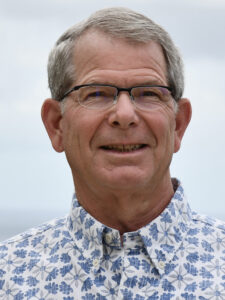Gregory Moore
University of Hawai’i
2022-2023 Distinguished Lecturer
Hows and whys of great earthquakes and tsunamis: New understanding from recent IODP drilling
The largest, most powerful earthquakes on Earth occur in subduction zones, where two lithospheric plates converge. Over the past three decades, ocean drilling has greatly advanced our understanding of these great earthquakes and the devastating tsunamis that accompany them, including one in 2004 off Sumatra, Indonesia and another in 2011 off Tohoku, Japan that killed hundreds of thousands of people.
At the Hikurangi convergent margin, also a site of large earthquakes and tsunamis, the subducting Pacific plate has many large and small seamounts and is covered by more than a kilometer of various kinds of sediment. Subduction of the seamounts causes extensive deformation on the overriding plate and may stimulate a special kind of earthquake called slow slip events. I will discuss the results from recent IODP Expeditions and associated 3D seismic reflection data from the Hikurangi subduction margin off NE New Zealand that provide new constraints on these processes.
In late 2017 and early 2018, IODP Expeditions 372 and 375 cored and logged sites on the incoming plate, at the toe of the overriding plate and within a basin landward on the upper plate, and emplaced long-term monitoring equipment in two of those holes. The cores and logs provide detailed information that we can extrapolate widely with a 3D seismic reflection data set that was also collected in early 2018. The 3D data provide knowledge of the oceanic basement and its overlying sediments and how they interact with the overriding plate to potentially cause great earthquakes and tsunamis.
Gregory Moore joined the University of Hawai`i as a Professor in December, 1988 after holding academic positions at Tulsa University and Scripps Institution of Oceanography. He earned a BA at UC Santa Barbara, an MS at The Johns Hopkins University, and Ph.D. at Cornell University. Dr. Moore has participated as a co-chief scientist on ODP Leg 190 and IODP Expedition 338; as a logging scientist on Legs 131, 156 and 172A, and Expedition 358; and as a member of the NanTroSEIZE Project Management Team for 12 expeditions between 2007 and 2019.
LECTURE SCHEDULE
- April 11, 2023 – University of Notre Dame, South Bend, IN
- April 14, 2023 – Appalachian State University, Boone, NC
- April 17, 2023 – Old Dominion University, Norfolk, VA
- April 19, 2023 – Cornell University, Ithaca, NY
- April 23-24, 2023 – University of Massachusetts Amherst, Amherst, MA







